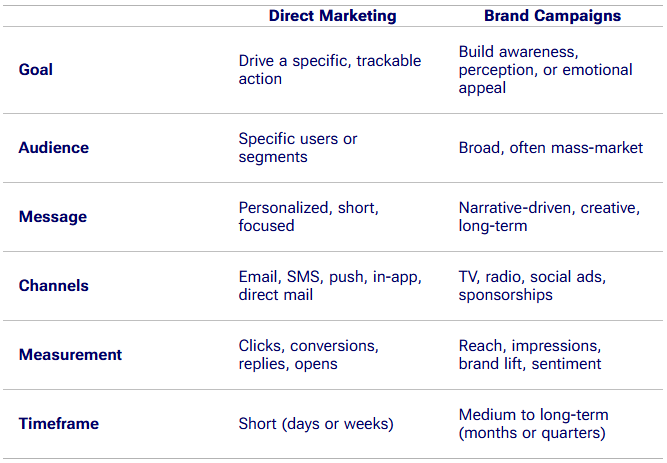
How AI Is Used in Mobile Advertising and Marketing Today
Understand what AI in mobile advertising means today. This article explains basic use cases, real examples, and why brands are starting to use AI.
.jpg?2025-11-14T09:43:42.256Z)
TOP 12 In-App Gamification Campaigns

Direct marketing is a form of communication where brands speak directly to individual consumers, without relying on third-party media channels. Unlike brand advertising, which aims to raise general awareness, direct marketing campaigns are focused on action. They are designed to generate a measurable response — a click, a sign-up, a purchase.
In modern practice, direct marketing spans multiple channels. Emails, SMS, in-app messages, and even printed mail all fall under this category, as long as the communication is targeted and response-oriented. Businesses use it to engage existing customers, re-activate inactive ones, or reach potential buyers with specific offers.
So, if you're wondering what direct marketing is, or how it compares to broader advertising approaches, this article offers a clear explanation. It covers the basics, outlines how these campaigns work, and includes examples of direct communication that drive results.
Direct marketing refers to any form of promotion that delivers a message straight to the consumer and invites a specific action in return. There’s no media intermediary — no TV slot, no banner ad on a website, no public-facing broadcast. Just a message sent directly from the business to a named individual.
That message might arrive as:
What makes it “direct” is not just the format. It’s the targeting and the intent. Direct marketing campaigns are usually built on customer data: purchase history, behavior, or preferences. They sent to segments or even individuals, not the general public.
The goal is always some form of direct response: open this, click here, buy now, update your profile. That’s why direct response marketing is often used as a synonym for this approach.
Well-run campaigns tend to be personal, relevant, and clearly structured. They don’t need clever slogans or long copy. They just need to be useful and sent at the right time.
A direct marketing campaign follows a simple path: a business sends a targeted message to a person and invites a measurable response. That’s it at the core. But the way it works in practice depends on the tools and data behind it.
Most direct marketing efforts start with a list either of customers, leads, or app users. This list may be segmented by location, purchase history, behavior, or preferences. Based on this segmentation, the business creates a message tailored to that group.
The message might be an email, a text, an in-app message, or even a printed postcard. But whatever the format, the content is designed to prompt action. That’s why direct marketing is often closely tied to direct response marketing. There’s always a next step: click, reply, buy, book, or update.
Here’s how it often looks in a mobile context:
Each of these examples involves direct communication, targeted delivery, and a built-in response mechanism. These campaigns don’t rely on algorithms or ad platforms to reach people. They go straight from brand to user.
In recent years, more businesses have started using AI in direct marketing to improve timing and targeting. For example, AI tools can predict the best moment to send a message or generate personalized subject lines. This helps improve performance without requiring more manual work.
The success of a direct marketing campaign is measured in clear terms: open rates, click-throughs, purchases, or replies. If no one responds, the campaign didn’t work. That clarity is part of the appeal especially for marketers looking to tie effort to outcome.
So whether you're working in e-commerce, mobile apps, SaaS, or even local services, the logic remains the same: send the right message to the right person at the right time. And make it easy to respond.
Direct marketing isn’t tied to a single format. What matters is the direct line between the brand and the recipient — and a clear way to respond. That’s what separates it from general advertising.
Over time, the list of direct marketing channels has expanded. Some are traditional, like direct mail. Others, like in-app messages or SMS flows, are built for digital products and mobile-first campaigns.
Here are the most common channels used in direct marketing campaigns today:
Still the most widely used channel in direct marketing. It’s measurable, personalizable, and easy to automate. Well-written emails with a clear offer and a single CTA often deliver high ROI.
Used for: product launches, reactivation, promotions, onboarding
Strengths: cost-effective, scalable, rich formatting
Weaknesses: inbox competition, deliverability issues
Fast, attention-grabbing, and direct to the user's phone. Great for urgent messages, limited-time offers, or reaching users not opening emails.
Used for: restock alerts, reminders, mobile-only discounts
Strengths: high open rates, mobile-friendly
Weaknesses: short format, opt-in required, easy to overuse
Part of the product itself. Triggered based on user behavior like onboarding, inactivity, or feature discovery. This form of direct communication feels native and timely.
Used for: tutorials, feature announcements, feedback requests
Strengths: contextual, no delivery delays
Weaknesses: limited reach (only active users), needs app integration
Yes, it still exists and still works in the right context. Useful for high-value offers or segments where digital channels underperform.
Used for: welcome packs, loyalty rewards, seasonal campaigns
Strengths: tactile, memorable
Weaknesses: slow, expensive, harder to measure
Used less frequently, but gaining traction. Some brands use WhatsApp or Instagram DMs for direct response marketing especially for service, support, or lead qualification.
Used for: reminders, 1:1 conversations, time-sensitive offers
Strengths: informal, real-time
Weaknesses: manual (unless automated), hard to scale without clear process
No single channel is always the best. Most effective direct marketing campaigns use a mix, depending on the goal, the message, and the user’s habits. In mobile marketing especially, timing and context often matter more than the channel itself.
Direct marketing is useful when you need a response. It’s not designed for broad brand awareness or storytelling. Instead, it works best when the goal is action: click, buy, sign up, return.
So, when does it make sense to run a direct marketing campaign? Here are common scenarios where using direct marketing makes a real difference:
Direct marketing is often used to keep existing users engaged. An email with a personal discount. A push notification about a saved cart. A message that says: “We noticed you haven’t logged in for a while.” This kind of direct communication helps reduce churn and improve lifetime value. It’s targeted, timely, and often automated.
When something new is available — a feature, a product, a plan — direct channels let you reach your audience quickly and clearly. Direct response marketing here focuses on fast action. Announce the offer. Show the benefit. Link directly to the CTA.
Inactive users are part of almost every list. Direct marketing gives you tools to bring them back. Think: a limited-time promo, a short survey, or even just a friendly “miss you” message. The key is to personalize and make the message feel timely.
Direct campaigns are also useful for gathering insight. A one-question in-app prompt. A survey link by email. A request for feedback after a purchase. These messages are small, but when timed well, they drive real value.
Compared to display ads or influencer sponsorships, direct marketing campaigns are relatively low-cost. Once your message is written, delivery is inexpensive especially via email or in-app channels. That makes direct marketing a strong fit for early-stage companies, niche products, or teams without huge media budgets.
In short, if you know who you want to reach and what you want them to do, direct marketing offers a simple and effective way to do it. It doesn’t require a massive budget or a viral idea. It just requires clarity, timing, and a clear path to action.
Running a direct marketing campaign is about sending the right message, to the right person, at the right time — and making it easy for them to respond. Here are key principles that make direct marketing campaigns more effective in real-world settings.
Before you write anything, define what you want users to do.
Open an email? Click a promo? Complete onboarding?
Everything else — message, channel, timing — depends on this.
Not every user should get the same message.
Use what you know: behavior, purchase history, location, or device type. Even basic segmentation improves results.
For example, showing a returning user a “welcome” message is a fast way to lose trust.
Even in automated systems, real people are reading.
That means clear language, short sentences, and one core message per campaign. Avoid jargon. Say what the user gets. Make it easy to say yes.
Every good direct marketing campaign has one clear action. Not three.
“Start trial” or “Add to cart” or “Tell us what you think.” That’s it.
Too many links? People pause. Or skip. Or delete.
A good message sent at the wrong moment is still a miss.
Use triggers (e.g. user just installed, just viewed a product, just became inactive) or schedule messages around logical points in the user journey.
In mobile marketing, timing is half the battle.
No campaign is perfect the first time.
Test subject lines. Try different formats. Measure click rates and response quality. Then adjust.
A/B testing in direct response advertising isn't optional — it's how you learn what works.
Outdated emails, unsubscribed users, or bad segments lead to bad results.
Clean lists, correct tags, and proper opt-ins are basic hygiene. Without them, even the best message will fail.
Well-run direct marketing campaigns don’t rely on volume. They rely on clarity, timing, and relevance. You don’t need a giant list. You just need to say the right thing — and say it well.
Not all marketing is meant to drive an immediate action. Some campaigns aim to build recognition, awareness, or trust over time. These are often called brand campaigns and they’re different from direct marketing campaigns in both purpose and design. Here’s how the two approaches compare:

That doesn’t mean one is better than the other. They serve different purposes and often work best when combined. For example:
In practice, most companies rely on a mix. Brand campaigns help people remember who you are. Direct campaigns give them a reason to act. If your team is small or focused on performance, direct marketing is usually the starting point. It’s faster to launch, easier to measure, and closely tied to results. But as your product grows, layering in brand campaigns helps build trust and recognition — the things users remember when they see your message later.
Whether it’s a one-time email, a triggered push notification, or an in-app message tied to behavior, direct marketing campaigns can drive action across the entire customer journey from activation to retention.
That said, direct marketing isn’t a replacement for long-term brand building. It’s a tool — one that works best when guided by data, tested regularly, and focused on clarity. The most effective campaigns are rarely the loudest. They’re just the ones that reach the right person and make it easy to respond.
If you’re working with a limited budget, or trying to create momentum without waiting on big creative cycles, using direct marketing is often the fastest way to learn, adapt, and grow. And once it works — scale it.

Read also